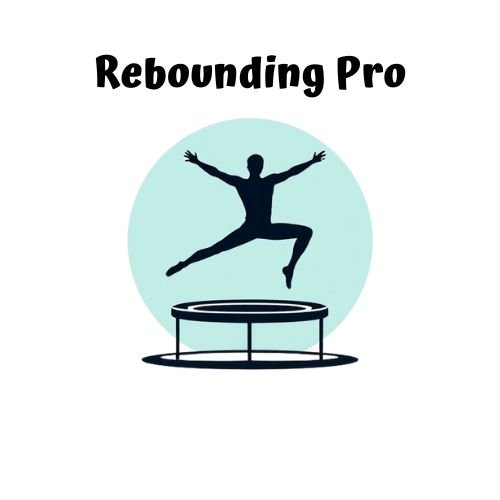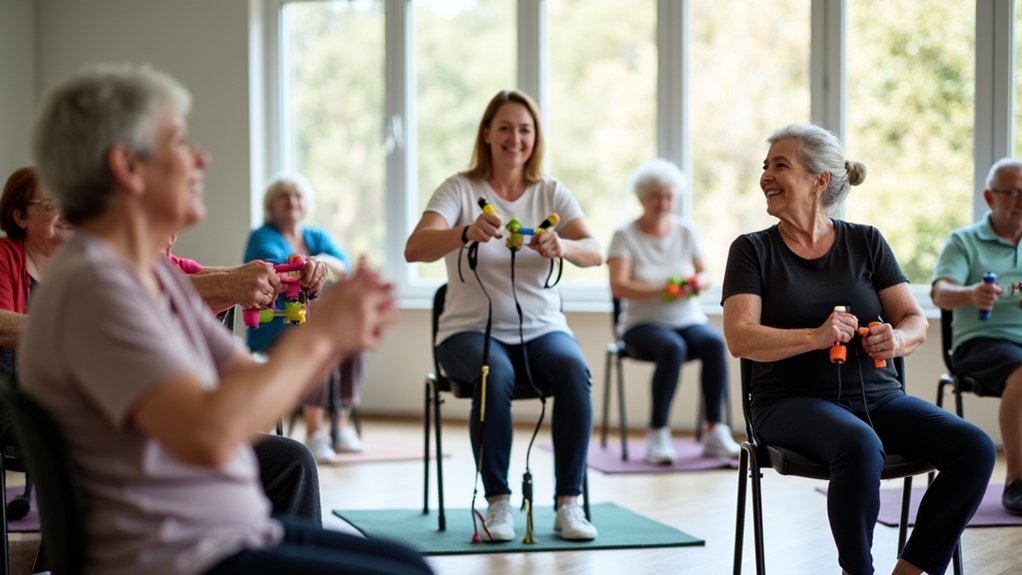Trampoline workouts burn more calories (300 in 30 minutes) than dance cardio (200-400 depending on intensity) while being gentler on your joints, absorbing up to 80% of impact. You’ll get similar heart rate benefits from both (around 148 bpm), but trampolining offers better core engagement and oxygen intake—NASA confirmed it’s 68% more effective than running. Both activities feel more like play than exercise, but trampolining’s unique benefits might give it the edge in this cardio showdown.
Trampoline Workouts Vs Dancing: Cardio Showdown

When it comes to getting your heart pumping, both trampoline workouts and dancing offer impressive cardio benefits with distinct advantages. NASA research reveals trampoline workouts are 68% more effective at increasing oxygen intake than running, giving them a significant edge for cardiovascular benefits.
Looking to maximize cardio? NASA found trampoline workouts boost oxygen intake 68% more effectively than running.
If you’re counting calories, trampolining burns approximately 300 calories in just 30 minutes, while dance cardio typically burns 200-400 calories depending on intensity and style.
The difference? Trampoline workouts deliver these results with minimal joint impact, making them ideal if you have knee or ankle concerns.
Both activities trigger endorphin release for mood enhancement, but many find the bouncing element of trampoline workouts particularly enjoyable.
You’ll improve balance and coordination with either choice, though trampolining offers the additional benefit of strengthening pelvic floor muscles.
The Science Behind Rebounding and Dance Cardio
Understanding the physiological impact of both exercise forms reveals why they’ve gained such dedicated followings. NASA research shows rebounding fitness is 68% more effective at increasing oxygen intake than running, giving it a significant edge over dance cardio for cardiovascular health improvements.
- Rebounding absorbs 80% of impact compared to running, making it gentler on joints than high-impact dance movements.
- A moderate 30-minute trampoline session burns approximately 300 calories, offering consistent intensity unlike variable dance cardio routines.
- Trampoline workouts uniquely strengthen pelvic floor muscles while improving balance and coordination.
- Both are workouts that feel good mentally, but rebounding’s playful nature often leads to better adherence and consistency in fitness routines.
Calorie Burn: Comparing Trampoline and Dance Workouts

For those seeking maximum calorie burn from their workouts, the comparison between trampoline rebounding and dance cardio reveals significant differences.
Your fitness trampoline session can torch up to 300 calories in just 30 minutes, outpacing typical dance workouts that burn between 150-250 calories in the same timeframe.
NASA research supports this efficiency, showing rebounding is 68% more effective at increasing oxygen intake than running. This translates to superior aerobic exercise benefits on your mini-trampoline.
While both activities elevate your heart rate to similar levels (around 148 bpm), the unique G-force experienced during trampoline workouts enhances your metabolic rate post-exercise.
This means you’ll continue burning calories even after you’ve finished bouncing—a significant advantage over traditional dance cardio routines.
Impact on Joints: Which Cardio Option Is Gentler?
Joint health remains a critical factor when choosing between trampoline workouts and dancing for your cardio routine. Rebounding offers remarkable protection for your knees and ankles, absorbing up to 80% of impact while still delivering cardiovascular fitness benefits.
- NASA research confirms trampolining is a low-impact exercise that effectively improves heart health without the joint strain common in high-impact activities.
- While dancing can strengthen muscles, styles involving jumping create significant force during landings, potentially leading to overuse injuries.
- 90% of trampoline users report no joint discomfort, making it ideal if you have existing joint concerns.
- Beyond joint protection, rebounding improves balance and coordination, further reducing your injury risk during exercise.
Cardiovascular Benefits: Heart Health Comparison

Beyond protecting your joints, your choice between trampolining and dancing greatly impacts your heart health. NASA research reveals trampoline workouts improve oxygen intake by 68% more effectively than running, providing superior cardiovascular fitness benefits.
When you bounce regularly, you’ll experience enhanced lung capacity and endurance while strengthening your pelvic floor muscles—particularly valuable if you’re a woman over 40. Your heart rate elevates consistently during trampoline sessions, improving overall cardiovascular health similarly to dance cardio.
Both activities effectively support heart health, but trampolining delivers comparable calorie-burning benefits—about 300 calories in just 30 minutes—while being considerably gentler on your body.
You’ll absorb up to 80% of impact during trampoline exercises versus the higher strain from dancing, making trampolining an effective yet kinder approach to maintaining fitness.
Muscle Engagement: Full-Body Analysis
Trampoline workouts activate multiple muscle groups simultaneously, creating constant resistance through G-force that engages your legs, core, and arms more intensely than most dance routines.
Your core muscles work especially hard during rebounding to maintain stability, whereas dancing challenges these muscles differently through rhythmic movements and postural control.
You’ll experience more consistent full-body engagement on a trampoline, while dance workouts vary in muscle activation depending on the specific style and choreography.
Muscle Activation Comparison
When comparing muscle engagement between trampoline workouts and dancing, both activities offer distinct patterns of activation that influence their overall fitness benefits.
Trampolining provides a unique full-body workout that simultaneously engages multiple muscle groups while maintaining low-impact on your joints.
- Trampolining activates fast-twitch muscle fibers, improving vertical jump height and explosive strength more effectively than many other exercises.
- Your core muscles remain constantly engaged during rebounding as they work to maintain balance on the unstable surface.
- Dance workouts primarily target lower body muscles, particularly in the legs and hips, with secondary upper body engagement.
- Trampoline training shows measurable improvements in muscle endurance, with an impressive 7.82% increase in VO2 max after eight weeks of consistent practice.
Core Engagement Differences
Core muscles function as the central stabilizing system during both trampoline workouts and dancing, though the manner and intensity of engagement differ substantially between these activities.
When you bounce on a trampoline, you’re activating your entire core network—including pelvic floor muscles—as your body constantly adjusts to maintain balance during rebounding.
While dancing engages your core through rhythmic movements and postural control, trampoline workouts deliver more thorough core engagement through the continuous stabilization required during bouncing.
NASA research confirms trampolining improves oxygen intake by 68% compared to running, intensifying your cardiovascular engagement while strengthening core muscles.
Additionally, trampoline exercises provide this full-body workout with minimal joint impact, making it accessible even if you have joint concerns—something dancing can’t always claim while still developing similar core strength benefits.
Coordination and Balance Improvements
Both dynamic forms of exercise offer remarkable benefits for those seeking to enhance their physical coordination and balance.
Trampoline workouts improve your proprioception through repetitive bouncing that engages multiple muscle groups simultaneously, while dance challenges your body with varied rhythmic movements that develop agility and control.
- Core Strength Development – Both activities strengthen your core, which serves as the foundation for better balance in all physical activities.
- Proprioceptive Training – Trampolines force constant position adjustments, enhancing your body awareness.
- Multi-directional Movement – Dance routines incorporate various directions and shifts that improve coordination.
- Low-Impact Benefits – Trampoline training provides balance improvements with reduced injury risk compared to high-impact exercises.
You’ll notice improved stability and coordination regardless of which activity you choose, with each offering unique benefits to your movement patterns.
Equipment Needs and Space Requirements
Trampoline workouts require a dedicated fitness trampoline with safety features, while dancing needs little more than comfortable attire and appropriate footwear.
You’ll need to allocate about 8-10 square feet for a compact trampoline setup, whereas dance routines typically demand at least 10-12 square feet for proper movement.
Your home environment plays an essential role in deciding between these activities, as trampolines work well in confined indoor spaces with sufficient ceiling height, while dance can be adapted to various surfaces and settings.
Equipment Essentials Compared
When choosing between fitness options, equipment accessibility often determines your commitment level. Trampoline workouts require specific gear, while dance workouts offer more flexibility with what you already have at home.
- Trampoline necessities: You’ll need a quality mini-trampoline like the DOMYOS Fit Trampo 500, plus about 8 feet of clearance space for safe bouncing regardless of your fitness level.
- Dance simplicity: Just comfortable shoes and enough room to move freely—making it immediately accessible.
- Space considerations: Trampolines demand dedicated areas with height clearance, while dancing adapts to virtually any space.
- Optional enhancements: Both activities can incorporate additional equipment—trampolines might need stabilizing bars for beginners, while dance workouts can utilize resistance bands for added intensity.
Space Needs Assessment
As you contemplate your fitness journey, understanding the spatial requirements for each activity becomes essential for success.
Trampoline workouts demand vertical clearance of at least 8 feet and approximately 10-14 square feet of floor space to guarantee safe bouncing. If you’re tight on space, mini trampoline workouts offer a more compact alternative perfectly suited for apartment living.
In contrast, dance workouts require more horizontal room—typically 15-20 square feet minimum—to accommodate full choreography movements and prevent restriction.
Both activities need appropriate flooring considerations: trampolines function best on stable, cushioned surfaces, while dance workouts thrive on smooth, non-slip floors that support pivots and steps.
Your living situation will greatly influence which option fits best, especially if you’re planning indoor sessions where ceiling height and available floor space become critical factors.
Accessibility for Different Fitness Levels
Both exercise modalities offer remarkable versatility across fitness spectrums, making them standout choices for beginners and fitness enthusiasts alike.
From beginner to expert, these dynamic workouts adapt to your level while delivering exceptional results.
When selecting a workout that’s right for you, consider how both trampolining and dancing provide excellent entry points for those new to exercise while offering advanced progressions.
- Start small, grow big – Begin your trampoline fitness routine with just 5-10 minutes, gradually building stamina while enjoying the low-impact benefits.
- Modify to fit your needs – Dance workouts can be tailored to any skill level, allowing you to adjust movements to match your capabilities.
- Full-body engagement – Both activities work multiple muscle groups regardless of your fitness level.
- Enjoyment drives consistency – The fun nature of these workouts encourages regular participation, a key factor in fitness progress.
Mental Health Benefits and Mood Enhancement
The profound impact of movement on mental well-being extends far beyond physical fitness, with both trampolining and dancing serving as powerful mood-enhancing activities. You’ll experience a rush of endorphins and serotonin during these workouts, greatly reducing anxiety and promoting mental wellbeing.
| Benefit | Trampolining | Dancing |
|---|---|---|
| Stress Relief | Immediate | Progressive |
| Cognitive Function | Improves focus | Enhances memory |
| Meditative Quality | Rhythmic bouncing | Flowing movements |
Both activities create a playful environment that keeps you motivated to maintain your fitness routine. The repetitive nature of trampolining improves balance while inducing a meditative state, similar to dancing’s rhythm-based movements. When you’re feeling mentally drained, either activity can help clear your mind, alleviate depression symptoms, and restore your mental clarity.
Long-Term Adherence and Enjoyment Factors
Why do some fitness routines fade quickly while others become lifelong habits? The answer often lies in enjoyment. Trampoline workouts turn exercise into play, making you more likely to stick with them compared to traditional cardio options.
- Enjoyment breeds consistency – When you’re having fun bouncing, you’ll maintain your routine longer than when exercise feels like a chore.
- Low-impact benefits protect your joints, reducing injury risk and keeping you active for years.
- Endorphin release during trampolining boosts your mood, creating a positive association that encourages regular sessions.
- Hybrid options combining dance elements with rebounding can satisfy diverse preferences, helping you find the perfect workout match for long-term adherence.
Combination Workouts: Merging Rebounding and Dance
Imagine elevating your fitness routine by combining the bounce of a trampoline with the rhythm of dance—this fusion creates an exercise experience that’s greater than the sum of its parts.
When combining rebounding with dance, you’ll boost your cardiovascular fitness while making workouts feel more enjoyable.
These hybrid sessions deliver a full-body workout through choreographed bouncing movements that improve your coordination and rhythm. You’ll burn up to 300 calories in just 30 minutes—comparable to traditional cardio exercises but with added fun.
Bounce your way to better fitness with choreographed trampoline routines that torch calories while keeping workouts playful and engaging.
For enhanced results, try incorporating light dumbbells to engage your upper body muscles during rhythmic movements.
The playful nature of trampoline dance workouts releases mood-boosting endorphins, reducing stress and transforming exercise from a chore into an activity you’ll actually look forward to.
Expert Recommendations and Trainer Insights
Personal trainers consistently recommend both rebounding and dance for different fitness goals, with most experts suggesting trampoline workouts for joint-friendly cardio and dance for those seeking creative expression with their exercise.
When selecting equipment, fitness professionals advise investing in a quality mini-trampoline with adequate weight capacity and stability features rather than budget options that might compromise safety.
You’ll find that certified instructors often suggest pairing either workout with strength training for ideal fitness results, regardless of whether you choose the rhythmic movements of dance or the bouncing dynamics of a trampoline routine.
Expert Trainer Comparisons
While both workout styles offer substantial fitness benefits, expert trainers have provided valuable insights into the unique advantages of trampoline workouts compared to dancing.
Fitness instructors emphasize that trampolining delivers comparable calorie burn to dance—up to 300 calories in just 30 minutes of moderate cardio workout.
- Joint Protection – Rebounding offers lower impact than many dance styles, making it ideal if you have joint concerns.
- Mental Engagement – Trampoline sessions feel more like play than exercise, encouraging long-term consistency.
- Respiratory Benefits – Regular rebounding can increase lung capacity and endurance more effectively than dancing.
- Versatility – You can incorporate dance elements into trampoline routines for enhanced coordination while avoiding the monotony that sometimes accompanies traditional dance workouts.
Professional Equipment Guidance
Having explored the expert comparisons between trampoline workouts and dancing, proper equipment selection becomes a key factor in maximizing your fitness results.
For effective rebounding, invest in quality fitness trampolines like the DOMYOS Fit Trampo 500 for stability or the budget-friendly OPTI Mini. Beginners should consider the HOMCOM Foldable model with a handlebar for balance support while learning routines.
These professional equipment options can absorb up to 80% of impact, making them gentler on joints than traditional dance workouts.
To enhance your trampoline sessions, incorporate Songmics light dumbbells for upper body engagement or add resistance bands to target multiple muscle groups simultaneously.
This combination creates a thorough cardio and strength training experience that rivals choreographed dance routines while providing better joint protection.
Frequently Asked Questions
Is Trampoline Better Cardio Than Running?
Yes, trampolining is better cardio than running. You’ll get 68% more oxygen intake, burn more calories, and experience 80% less joint impact while achieving similar heart rates with more enjoyment.
Is 10 Minutes on a Trampoline Equivalent to 30 Minutes of Running?
Yes, you’ll get similar cardiovascular benefits from 10 minutes of trampolining as you would from 30 minutes of running. Research shows this time-efficient workout delivers comparable cardio results in just one-third the time.
What Are the Disadvantages of Trampoline Exercise?
You’ll risk sprains and falls without proper form. You might struggle with balance initially, and it won’t build much muscle strength. It’s ineffective without consistency, and you should avoid it with certain health conditions.
Is Bouncing on a Trampoline Good for Weight Loss?
Yes, you’ll burn up to 300 calories in just 30 minutes of bouncing. With increased post-workout metabolism and NASA-backed efficiency, consistent trampoline exercise 3-4 times weekly can deliver noticeable weight loss within a month.
In Summary
You’ll find both trampoline workouts and dancing offer excellent cardio benefits, though they’ll suit different preferences. Whether you’re bouncing on a rebounder or moving to your favorite beats, you’re improving your heart health while having fun. Don’t feel you must choose just one – many fitness enthusiasts combine both to keep their routines fresh. The best cardio exercise is ultimately the one you’ll stick with consistently.





Leave a Reply